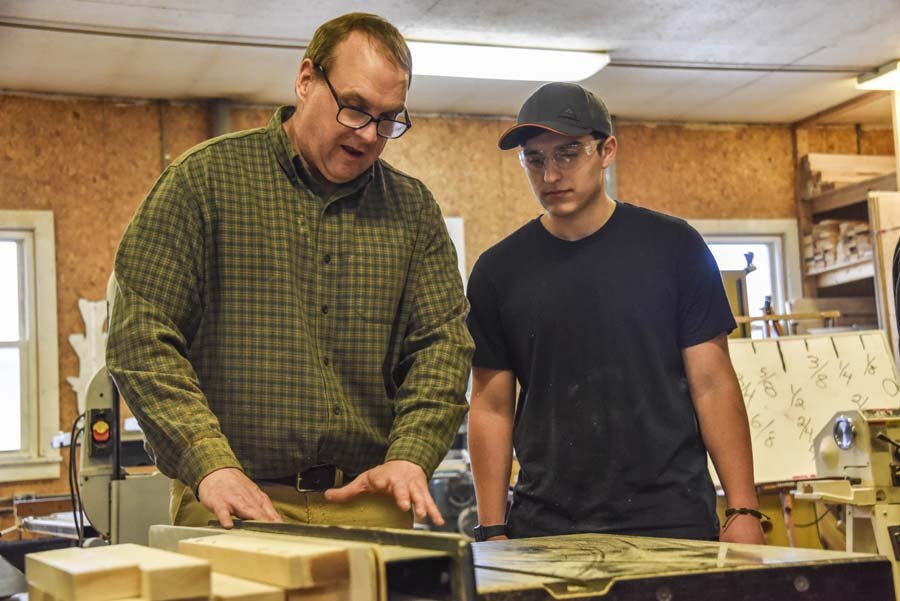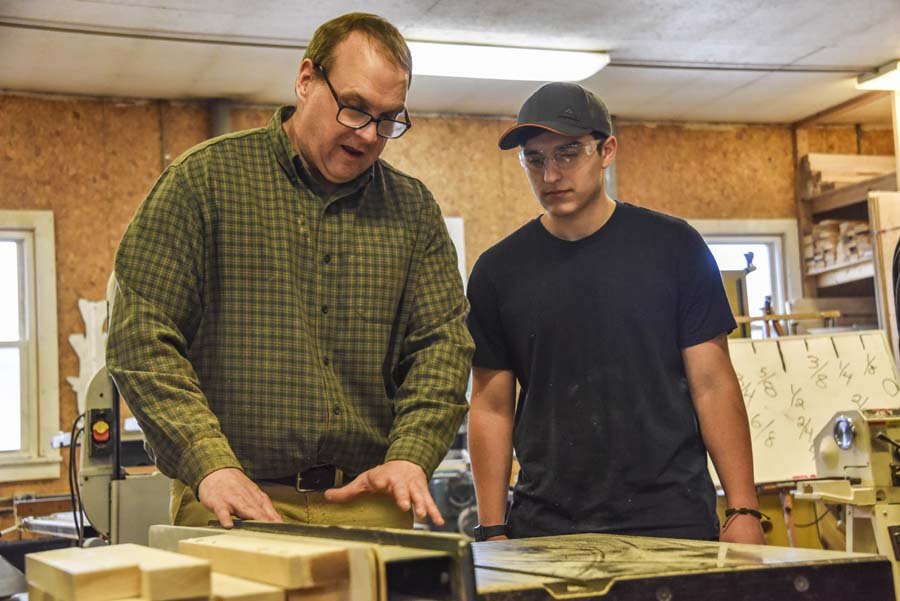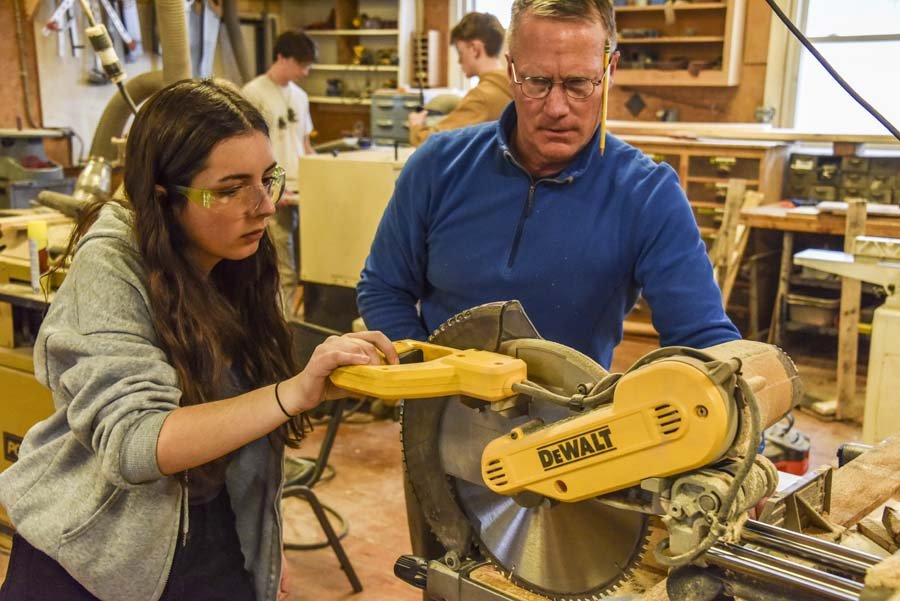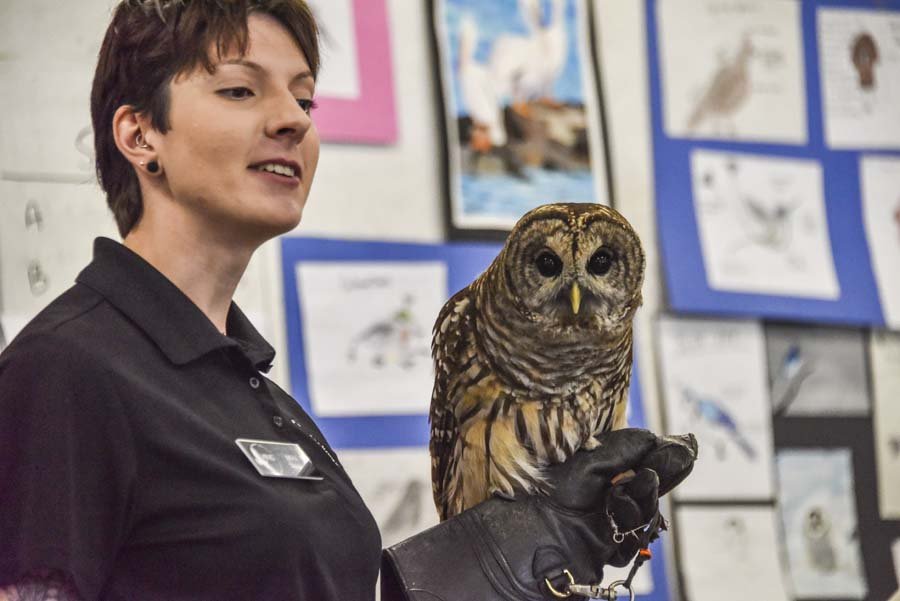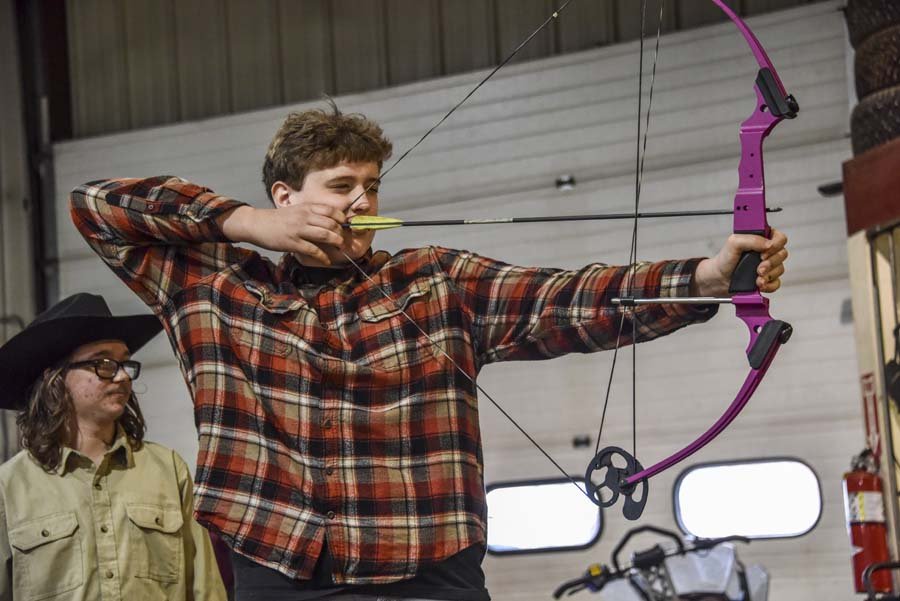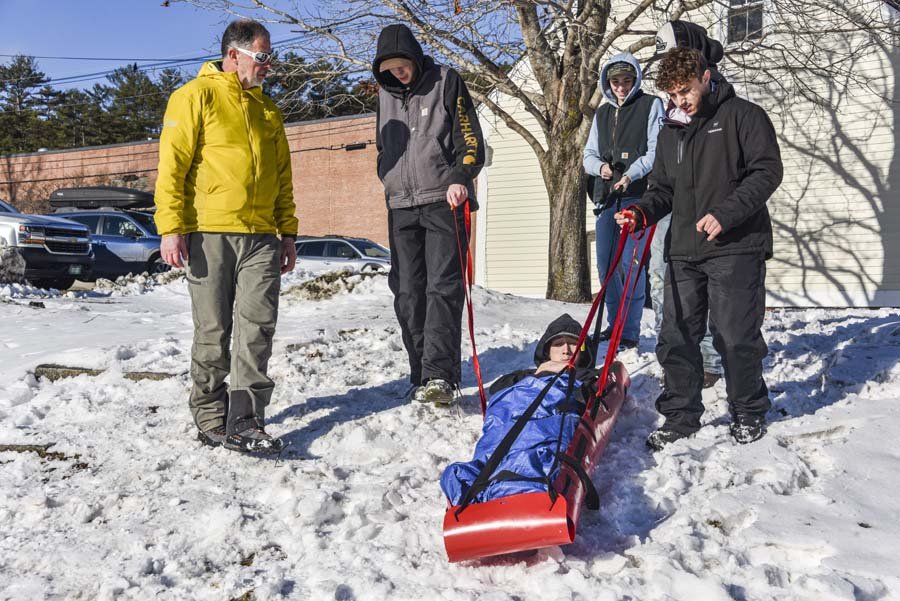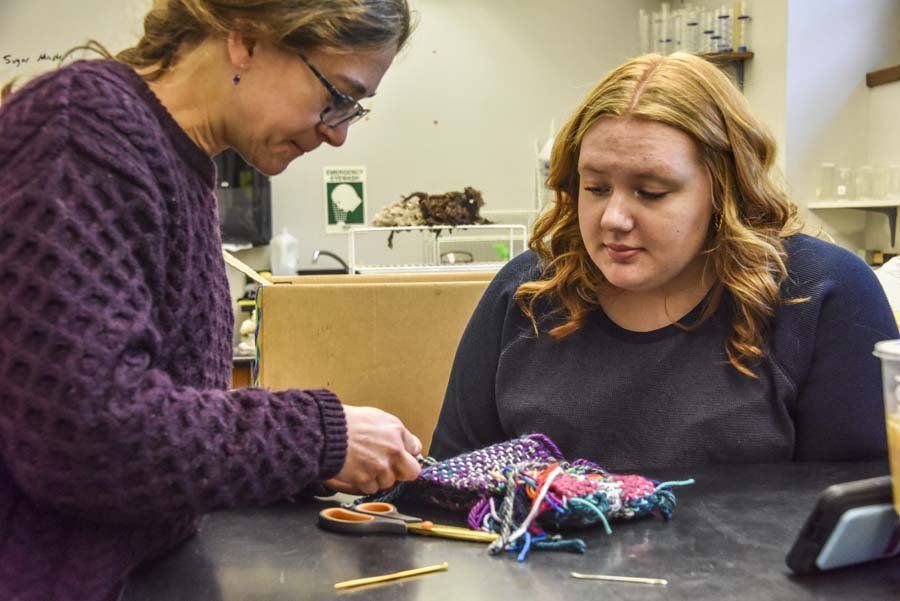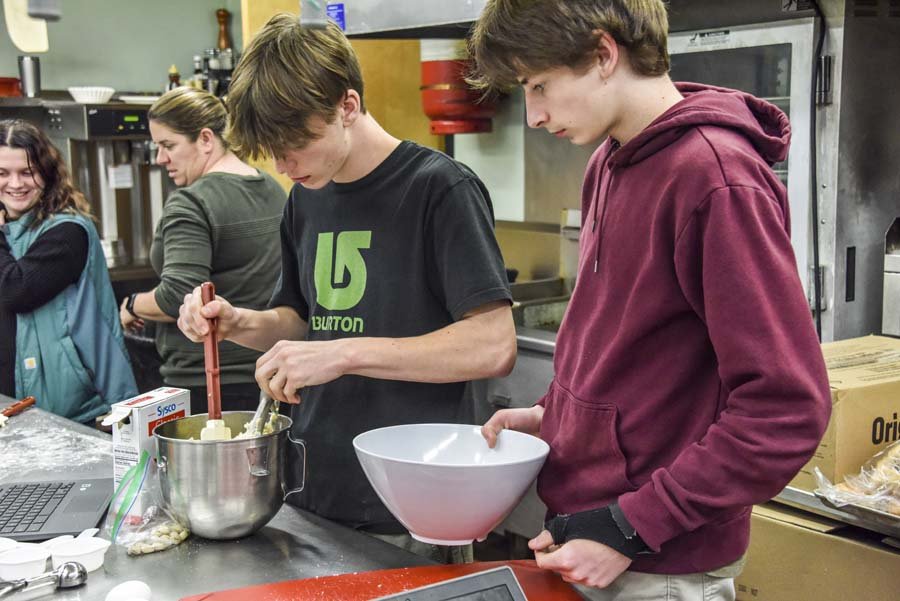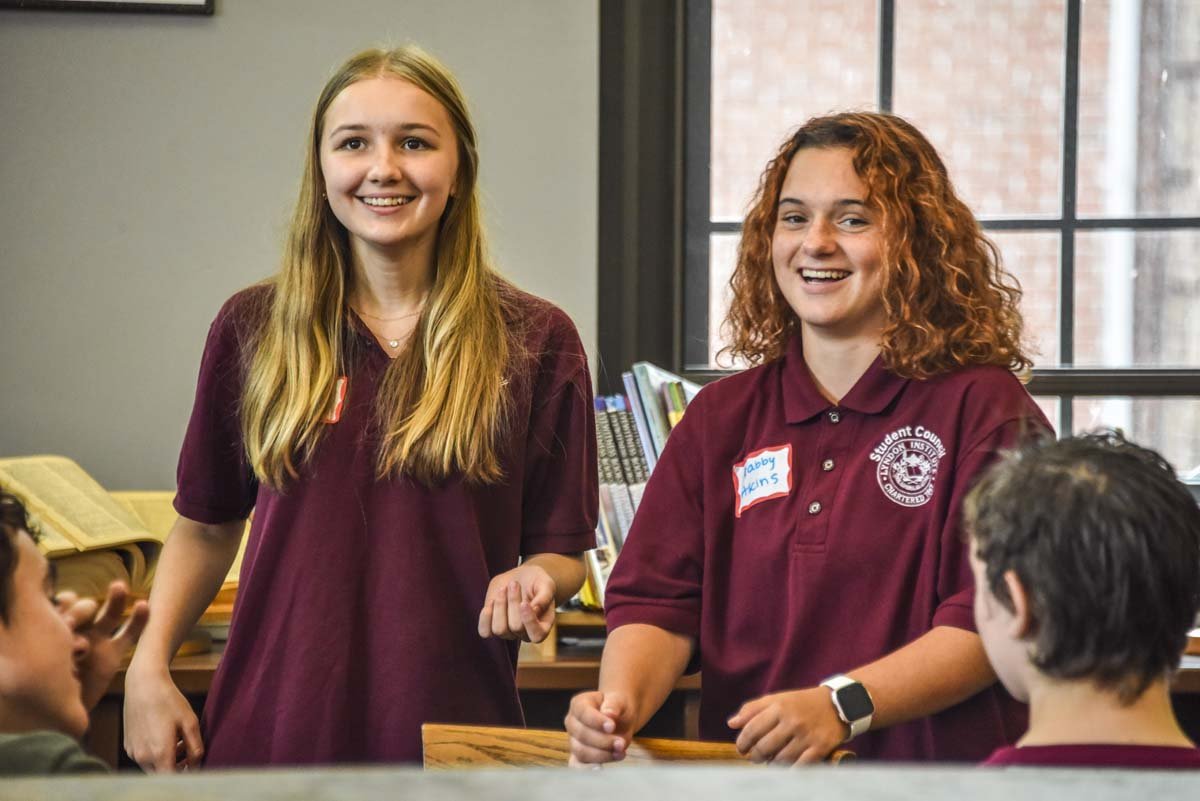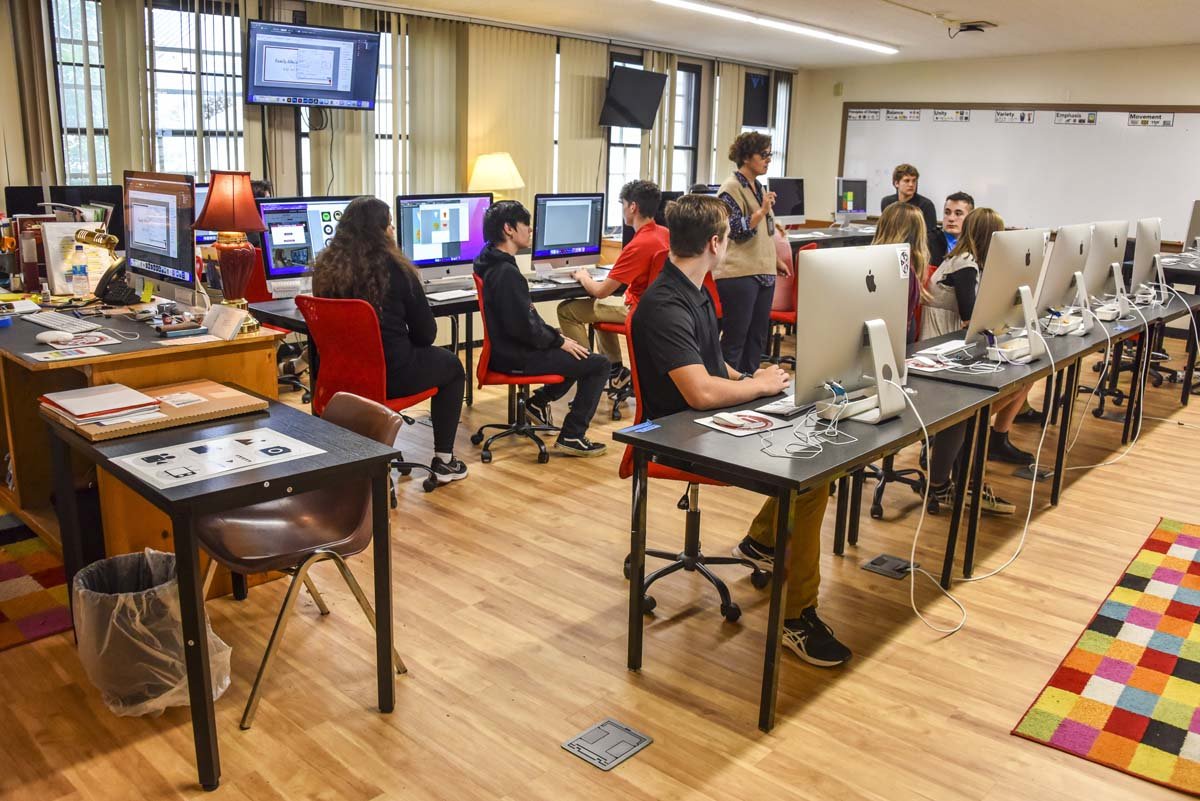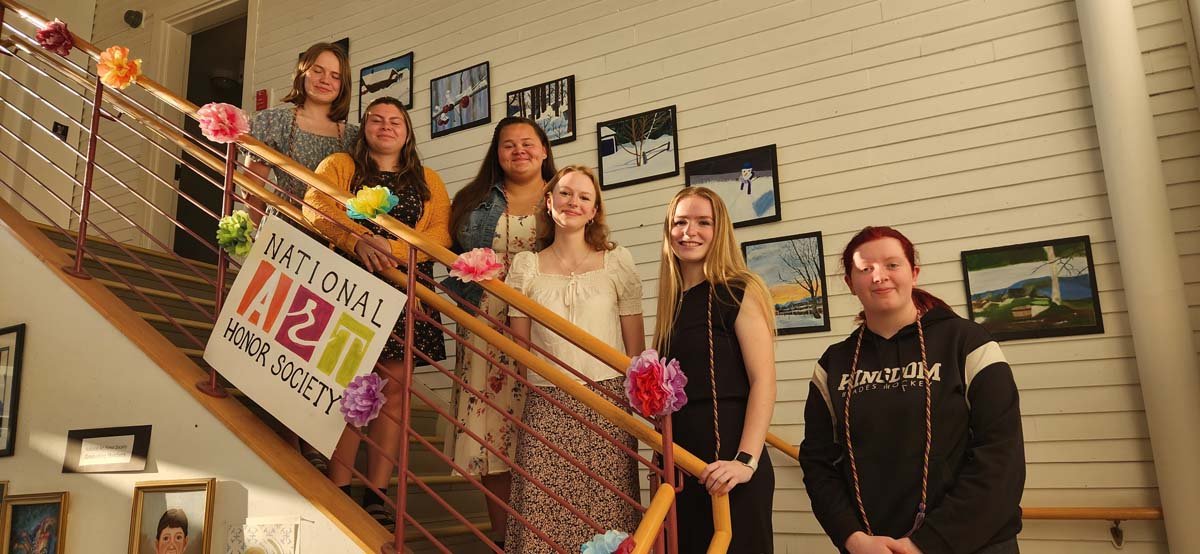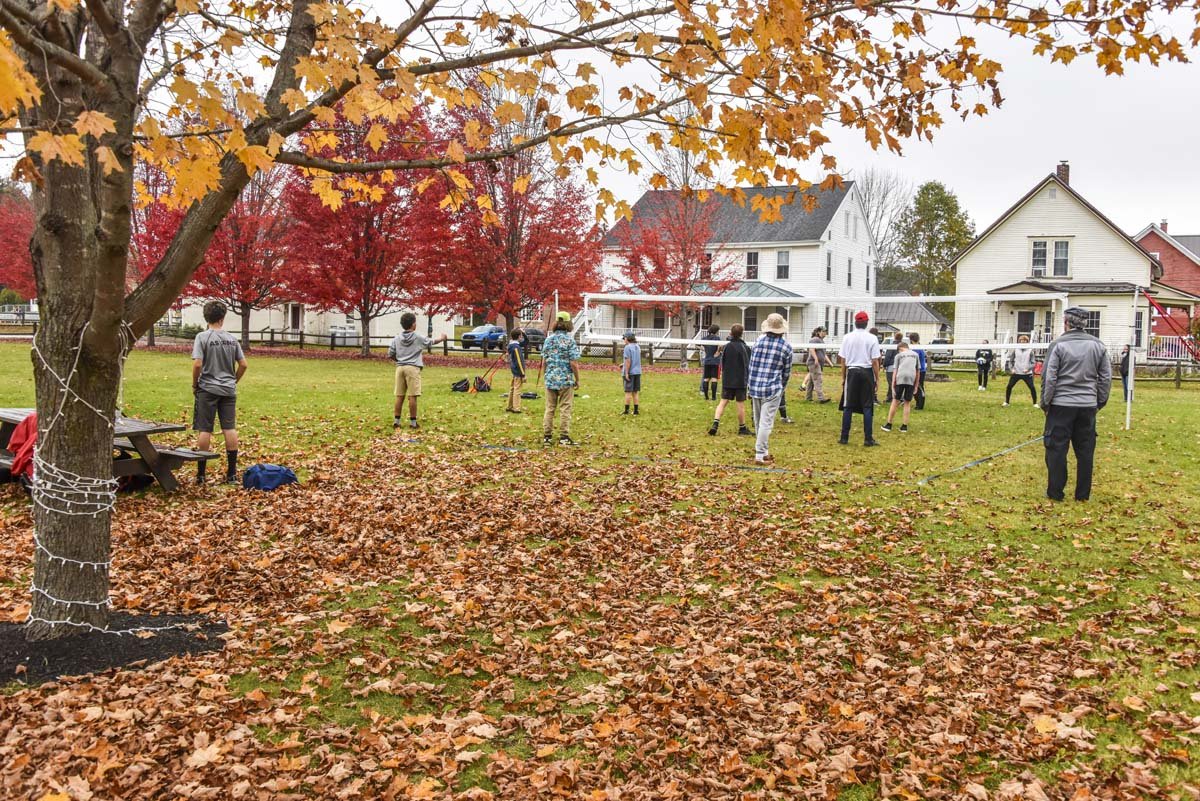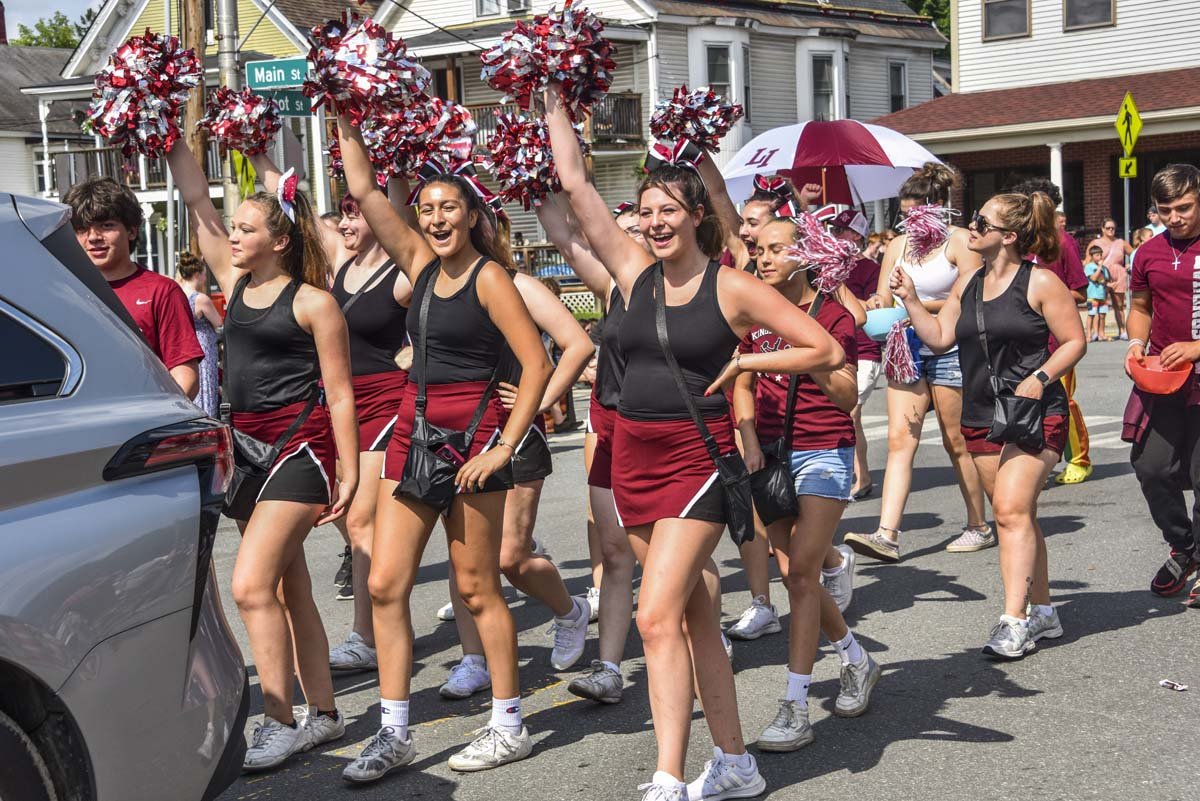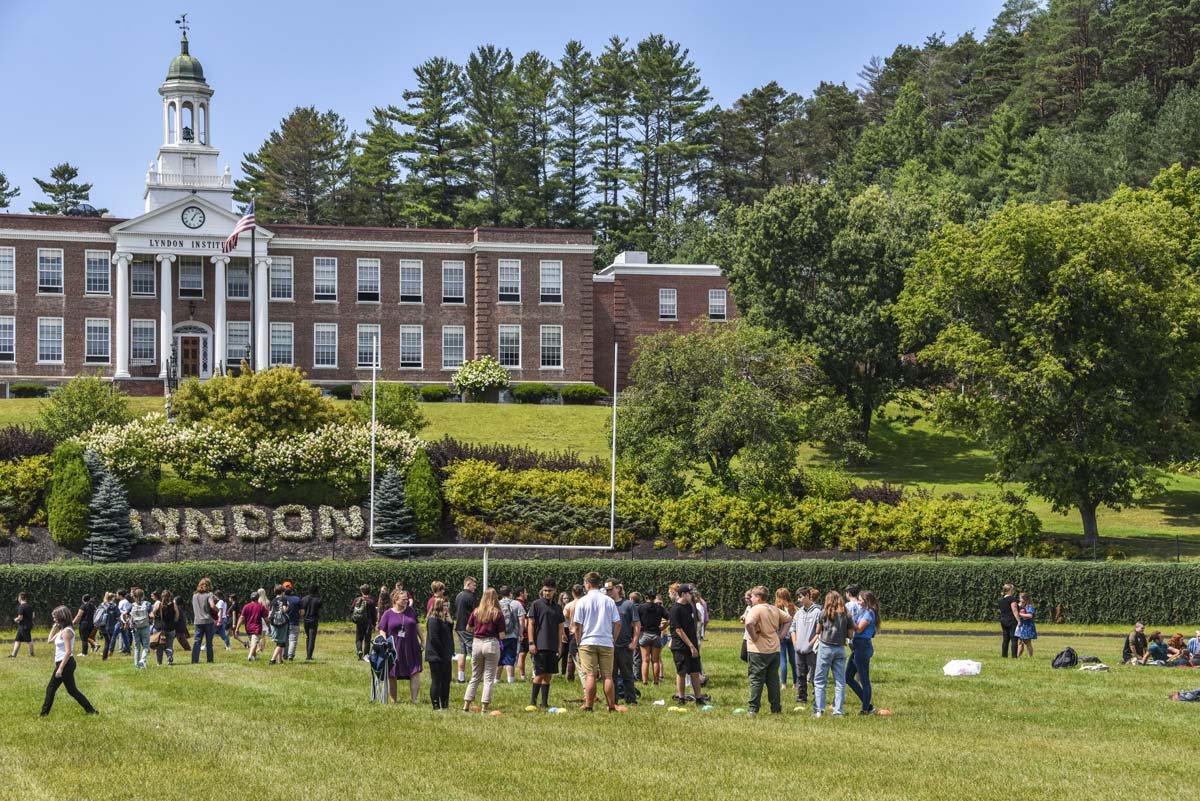- Our School
- Admissions
-
Academics
- Divisions and Faculty
- Commencement 2024
- January Term
- International Program (ESOL)
- College and Career Counseling
- Upward Bound
- Library/Monahan Academic Commons
- Career/Technical Education
- Lyndon Learning Collaborative
- Flexible Lyndon Institute Pathways (FLIP)
- Specialized Instruction
- Adult Continuing Education
- Lyndon Institute Course Catalog
- Student Services
- Arts
- Athletics
- Campus Life
- Support LI
- Alumni
« Back
A Decade of J Term
February 13th, 2024
A Flagship Program Turns Ten
By David Stahler Jr.
The hot air balloon rises into the frigid air on Lewis Field, its rainbow colors looking even brighter against the snowy white background as students gather to watch—not just down on the football field but from the windows of the Main Building up above. The new WCAX bell tower webcam offers an HD view for those engaged elsewhere around campus (and other parts of the world).
Normally, a hot air balloon in the dead of winter would be a startling sight, but this is January—J Term—a time of year at Lyndon Institute where anything can happen and wondrous sights are the norm.
J Term, one of LI’s signature programs, embraces the spirit of innovation, of exploration, of experimentation—both in the classroom and outside of it—in a variety of innovative ways. It is itself a grand experiment in education, one that has now just completed its tenth year and is still going strong.
For nearly all high schools, when students return from the holidays, it’s business as usual. But for the past decade, LI students have come back from their semester break for three weeks of project-based learning and other unusual opportunities to expand their education. J Term is about shaking things up.
Origin Story
“It all started in spring of 2014,” said Adam Norwood, who was Assistant Head for Academics and now serves LI as its Lyndon Learning Collaborative Coordinator and adjunct faculty in addition to his work with the Upper Valley Educators Institute. “It was [then Head of School] Rick Hilton’s last year, and we were considering ways to innovate. I thought, we’re an independent school—we can do anything we want!
“So I organized an open meeting for anyone on the faculty who wanted to come, just to have a conversation. If you could reinvent school from scratch, what would it look like? That first time, about six or eight people showed up. We had a great discussion. So I offered another meeting. About twice as many came. By our third meeting, the concept for a J Term started taking on a life of its own.”
Norwood was in the midst of his doctoral studies in education at Northeastern University, so he invited one of his professors, Chris Unger, to come up and see if he could offer some guidance.
“We met in the Seaver Seminar Room. It was packed. We had everyone go around the room and introduce themselves, say their name and their role at LI. After they’d finished, Chris said, ‘Okay, let’s try that again. This time, instead of your role, tell me something you’re passionate about!’
“So we did. Someone said they made furniture. Someone else said they were obsessed with elephants. Another talked about their talent with song-writing. It gave the introductions a whole different feel.”
Unger asked the group of teachers, “What if you could invent a class around your passion? What would that look like?”
Another question followed on its heels—What if we did Project Based Learning for three weeks?
Project Based Learning (PBL) is a teaching method in which students engage in “deeper learning” through in-depth research, hands-on projects, and real-world challenges.
“From the beginning, J Term was framed as an opportunity for teachers to experiment with new designs and new pedagogies. The expectation isn’t that everything is awesome all the time. Some amazing things come out of J Term, and sometimes teachers learn what doesn’t work and make improvements the following year or just try something different. The advantage of a three-week term is that if something doesn’t work, it doesn’t blow up a student’s overall learning experience.”
The first couple of years were pretty unstructured. “As long as it was safe, legal, and within budget,” Norwood joked, “teachers were free to do whatever they wanted.”
But soon, a greater emphasis on deeper learning developed. In recent years, this has taken the form of consciously incorporating Lyndon’s Transferable Skills initiative into the curriculum. Last year the focus was on ”Clear and Effective Communication.” This year “Collaboration” and “Self-Direction” took center stage.
“There’s tremendous value in implementing our Transferable Skills across the curriculum,” said Terha Steen, LI’s Dean of Academics. “It not only helps give each individual course an opportunity for deeper learning and focus, it offers a sense of cohesion. It gives us a common language—students are hearing the same terms and thinking about the same concepts in all their classes.”
All Hands On Deck
Like her predecessor, Norwood, Steen has championed J Term over the last several years, facilitating more planning time and collaboration for faculty through the fall in the lead-up to January.
“We’re so lucky to have J Term,” she said. “We kind of take it for granted at this point. When people hear about the kinds of opportunities students have, they’re always amazed. It’s just exciting to be able to engage both with kids and content differently.”
Head of School Dr. Brian Bloomfield, who implemented a J Term program at his previous school, echoed Steen’s excitement. “It gives our students a chance to have active engagement with learning, in some cases more authentic learning. But I also love that it helps our students get to know their teachers in new ways. They get to see us as more than just subject teachers when we embrace our passions and share what we love most.”
This ends up being true not just for faculty but staff, as well. Many J Term classes are taught by administrative staff or faculty who are not normally classroom teachers. In his first two years at LI, Dr. Bloomfield has taught classes in public speaking and—this year—the art of fencing. Librarian Trisha Jackman offers both a book publishing class and a bodybuilding class targeted to young women. Director of Operations Rick Angell’s course has students crafting wooden chess boards and 3D printing chess pieces, while Director of Technology John Peters teaches a course on network wiring standards that offers a path toward an industry certification if a student is interested.
J Term offers teachers not only a chance to be innovators in the classroom but another valuable opportunity, as well—a chance to work together. I often joke that teaching is, ironically, one of the loneliest professions—you are surrounded by others all day but may only get a chance to interact with another adult for a handful of minutes. This J Term, over twenty classes were co-taught, giving teachers a chance to work together for at least part of the day.
Social Studies teacher Paul Scavitto experienced the value of such partnerships this year; he co-taught all of his J Term courses this year with a variety of colleagues. “It’s not just important, it’s essential. I would argue the primary success of my J Term this year was due to co-teaching.
“A lot of what we’re doing in these classes we’ve never done before. Co-teaching allows you to bounce ideas off of each other in the moment and get rapid fire feedback on the fly. Being able to evaluate and make adjustments like this is much harder to do when you’re by yourself.”
A Catalog of Wonders
Perusing the J Term catalog (available on LI’s website), one uncovers an eclectic but well-rounded curriculum. There are the ever-popular cooking classes, each with a different focus, from understanding different cultures through baking to learning to cook meals on a budget to exploring recipes and designing a cookbook. There are gaming classes, from role-playing games that lead to fiction writing experiences to board games that teach history.
There are classes that emphasize hands-on skills—archery, knot tying, fly tying (and actual flying with “Fly LI”), self-defense, woodworking, tapestry weaving, Rubik’s cube solving, and stop-motion animation to name just a few. And then there are the classes that emphasize more cerebral skills—incorporating meditation into daily life, navigating self-care and social media, developing skills for professional life, learning how to critique conspiracy theories.
Some come out of left field—designing a food truck business, building furniture (or even tiny houses) from wooden pallets, using data to create a fantasy sports team. Others get students out into the local schools; one class has its members teaching French to third graders at LTS, another focuses on daily mentoring at nearby Riverside School.
Roy Starling, Riverside’s Head of School and former LI Latin teacher, is a fan of the program. “We love having the students come during J Term,” he said. “It accomplishes two goals, really. It gets LI students more involved in the broader community, while giving them an important opportunity to grow. Working with younger students isn’t easy, and a lot of them end up finding strengths they didn’t know they had. It both enriches our program while broadening their horizons. It’s a win-win!”
During J Term, students even have an opportunity to teach their peers—when my son was a student at LI, he taught a digital music production class for two years, not only sharing a passion of his own but getting a great tutorial on education from his cooperating teacher.
Going Beyond the Classroom
J Term also provides opportunities for students to go more deeply into endeavors that would be part of their normal routine. Members of the alpine ski team head up to Burke after lunch during J Term for several extra hours of daily training than they would normally be able to have, a huge boon to their development. Three years ago, the annual school musical started using J Term as a half-day program to offer more in-depth rehearsal time. This year, LI added supporting classes in stage tech and set and costume design, helping push the production to a new level.
But J Term is more than just classes at LI. Job shadowing and internships have been a valuable part of the J Term experience over the last several years, allowing students to explore potential career paths and allowing local employers and professionals to identify and develop potential employees.
“We had forty-eight students pursue internships this J Term,” said Michelle Parson, LI’s Work Based Learning Coordinator. “Quite a few were matched in healthcare-related work places—NVRH, physical therapy practices, long term care facilities. We had students interning at auto repair shops and dealerships, veterinary clinics, schools. Others worked with local contractors, electricians, and farmers.
“The value of work based learning during J term is far reaching; I have students who have been hired after experiences, students who have had some career exposure that has lead them to either stay in the field or to shift to another, and students who have made a bigger impact on their placement than their placement has made on them.”
Senior Molly Smith spent the last two J Terms interning with physical therapist Michael Matteis at Dan Wyand, P.T. & Associates. A three-season varsity athlete, Smith has long had an interest in the field. “It’s hard sometimes to take in the grand scheme when you’re thinking about the future,” she said. “Being able to have this internship over two years really helped narrow my focus and gave me that piece of reassurance in terms of my college application process and career plans.”
The experience has helped her not only sharpen her focus, it’s helped develop some important life skills, as well. “It’s given me huge insights on how to interact with different people. When you’re in class all day, surrounded by like-minded peers, you don’t think too much about it. But working with a range of people of different ages and backgrounds, many of whom are in pain or discomfort, has really taught me the value of compassion.”
J Term’s three-week length also offers a unique chance for more extended travel, another great opportunity for learning. Over the years, students have gone on trips to New Orleans and Washington DC. This year, forty students embarked on a twelve day trip to Europe, a journey that actually began during last year’s J Term, when the students took a J Term class that explored the destinations they visited this year. Their trip took them from the beaches of Normandy to Flanders Fields, from the top of the Eiffel Tower to Buckingham Palace.
Math teacher Tim Ulrich has helped lead each of the last three trips and will be taking the next group of juniors and seniors to Italy and Greece in 2026. “Travel is the ultimate test of collaboration and self-direction,” he said, referencing this year’s Transferable Skills of focus. “When traveling, you need to learn to solve little problems quickly—navigating TSA and Passport Control, for example. It puts our students in position to guide themselves and help each other through new situations and challenges.”
Senior Josie Rowell, who joined this year’s trip to Belgium, France, and England, gained a lot from the journey. “Travel is as enriching as any J Term class. J Term is all about interacting with learning on a more physical level. Walking through cities, museums, and historical sites, seeing other cultures first-hand, gives you that kind of experience.”
It ended up having an unintended side benefit for Josie, as well. “I’m taking AP Euro this year. Being able to visit all these places I’m reading about in my textbook and see everything in person has made the material clearer and more interesting.”
An Evolving Project
J Term is a dynamic undertaking—always in a state of change. The same spirit that animates work within the classes embodies the program as a whole. Over the years, LI has experimented with two week sessions instead of the normal three, has tried three daily blocks instead of the normal four. Because so many J Term classes are tied into individual teachers’ passions, as teachers leave and new teachers come on board, courses come and courses go. (Faculty are also encouraged to rotate new courses into the mix every year to keep things fresh.)
Some early signature classes have faded into the past—or at least gone on hiatus. Susanne Norwood’s “A Lyndon Home Companion,” a riff on National Public Radio’s famous “A Prairie Home Companion” variety show, was an early highlight. Combining music, skits, and humor and produced entirely by students, the class featured the best of what J Term can make possible.
And the unexpected turns that a J Term class can take. One of the class’s first student directors—Katie Ham ‘15—reached out to Prairie Home Companion’s host and creator, Garrison Keillor, to ask for his advice on how to put together a good variety show. Keillor not only reached back—posting her letter and his response on the show’s website—he invited the class to a dress rehearsal and live broadcast of the show the following November.
Other early signature classes still exist, one of the best-known being Spanish teacher Chris Manges’s “How To Thrive In Winter.” The three-block class, designed to get LI students out into the winter wild, has been a J Term staple since the program’s first year.
“A lot of people think it’s a survival class, but the goal is to go beyond that. How can you not only survive in the winter woods but be comfortable and enjoy yourself?”
Students still spend most of their time outdoors in the snow, but even this class has evolved and changed over the years. First, a wilderness first aid and CPR certification component was incorporated. Later, the course became co-taught, with the role of Manges’s partner now filled by Anna Saco, LI’s Outdoor Recreation Program instructor.
“We do more field trips now than in the past, including trips to [LI’s Burke Mountain property] Binney Woods and overnights to the Wheeler Pond Cabins. Now that Anna has joined us, we have more gear and someone with other skill sets. But at the end of the day, she and I joke that ‘The Outside’—particularly Vermont’s winter environment with all its challenges—is the best teacher.”
Exhibition Night and Beyond
J Term may be dynamic in its changing nature, but one major constant has been its finale. Each three-week term ends with Exhibition Night, when the public is invited into the school to see the fruits of all this labor. Nearly every part of the upper campus is busy. Tables of finished products, slideshows, and displays fill the hallways. Presentations draw visitors into classrooms. The auditorium features performances; the cafeteria offers buffets of various dishes students have learned how to cook and bake. Quinzees—igloo-like snow shelters—surrounded by paper lanterns and a warm fire welcome visitors near the school’s main entrance. Students are on hand to show their parents and their peers what they’ve learned, what they’ve accomplished.
What will the next ten years bring for J Term?
“We don’t want to become complacent,” Steen said. “J Term is the place to experiment, so we’ll continue to think about what we can accomplish.” She emphasized the need to consider students’ changing needs and interests, citing, for example, recent new courses in mindfulness and general well-being in the wake of COVID.
Both Steen and Bloomfield expressed the importance of trying to implement the lessons learned through J Term’s experimentation into the regular curriculum.
“We’d like to see how we can maintain the spirit and energy of J Term and bridge this work into our regular classes, particularly as we focus more on our Transferable Skills,” Steen said.
Bloomfield agreed. “We’d like to see J Term serve as a model for a more vibrant, more modern form of education.”
Posted in the categories Front Page, Alumni.

